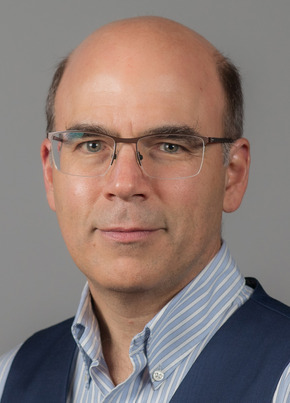Kyba Lab/Experimental Tissue Regeneration Lab
Laboratory Focus:
Our work focuses on factors regulating tissue degeneration and regeneration, with a view towards using cell therapy for regenerative medicine. The work spans two organ systems: the hematopoietic and the skeletal muscle systems and focuses on the role of transcription factors that regulate the regenerative response, or lead to degeneration when they go awry.
Specific projects:
Regulation of satellite cell quiescence and self-renewal: Skeletal muscle has tremendous capacity for regeneration after injury, but does not normally experience significant turnover. Satellite cells, the stem cells for skeletal muscle, are therefore quiescent. We are investigating mechanisms of regulation that govern quiescence and self-renewal of satellite cells, with a long-term goal of applying these to cell therapies for muscle diseases.
DUX4 and FSHD: The genetic disease facioscapulohumeral muscular dystrophy is caused by mutations leading to inappropriate expression of the double homeodomain transcription factor, DUX4. We are investigating the molecular mechanisms by which DUX4 recognizes DNA, alters chromatin and activates transcription, and are actively engaged in a program to discover and develop small molecule inhibitors of DUX4 for the treatment of FSHD. We have also developed an animal model for FSHD based on regulated, titratable expression of DUX4 in skeletal muscle.
DUX4 and cancer: Translocations that insert DUX4 into the IgH locus cause childhood and adolescent B cell leukemia. We are investigating the molecular mechanism underlying the oncogenic activity of DUX4-IGH fusion proteins. In addition, CIC-DUX4 fusions lead to an aggressive pediatric sarcoma named CDS. We are investigating new approaches for treating CDS based on inhibition of DUX4 and its cofactors, p300 and CBP.
Repopulating hematopoietic stem cells from pluripotent stem cells: We established the first efficient system for doing this in the mouse model, but the field still has not been able to generate repopulating HSCs from human iPS cells in an efficient manner. We are investigating novel approaches to differentiation of pluripotent stem cells in an effort to enable bone marrow transplantation from iPS cells.
Postdoc, graduate and undergraduate student positions are available. Please contact Dr. Michael Kyba at kyba@umn.edu if you are interested in joining the group.
Co - Investigator
Darko Bosnakovski, DVM, PhD (Assistant Professor)
Postdocs:
Asma Ahsan, PhD
Zahra Khosrowpour, PhD
Ahmed S. Shams, MD
Haitham Sobhy, PhD
Pelin Yegen, MD
Lab Manager:
Erik A. Toso, MS
Technician:
Ana Mitanoska
Undergraduates:
Aiden Boechler
Caleb Dewbery
Yihe Huang
Sana Ikramuddin
Nabiha Imtiaz
Neha Karri
Ameya Komaragiri
Sydney Peng
Garima Puri
Nivedha Ramaswamy
Caitlin Seaman
Asher Shertok
Abigail Teal
Su Tin
Srikara Vishnubhatla
Margaret Yarie
Administrative Contact:
Sarah Jutila Peterson juti0009@umn.edu
Bosnakovski D, Shams AS, Yuan C, da Silva MT, Ener ET, Baumann CW, Kyba M. (2020). "Transcriptional and cytopathological hallmarks of FSHD in chronic DUX4-expressing mice" J Clin Invest 103:2465-2477.
Kyba, M. (2020). "Replication of bone-marrow pathophysiology" Nat Biomed Eng 4:364-365.
Larson AA, Baumann CW, Kyba M, Lowe DA. (2020). "Oestradiol affects skeletal muscle mass, strength and satellite cells following repeated injuries" Exp Physiol 10: 1700-1707.
Bosnakovski D, da Silva MT, Sunny ST, Ener ET, Toso EA, Yuan C, Cui Z, Walters MA, Jadhav A, Kyba M, (2019) "A novel P300 inhibitor reverses DUX4-mediated global histone H3 hyperacetylation, target gene expression, and cell death" Science Advances 5: eaaw7781.
Collins BC, Arpke RW, Larson AA, Baumann CW, Xie N, Cabelka CA, Nash NL, Hanna-Kaarina J, Laakkonen EK, Sipilä S, Kovanen V, Spangenburg EE, Kyba M, Lowe DA. (2019) "Estrogen Regulates the Satellite Cell Compartment in Females" Cell Reports 28: 368-381
Chan SSK, Arpke RW, Filareto A, Xie N, Pappas MP, Penaloza JS, Perlingeiro RCR, Kyba M. (2018) "Skeletal muscle stem cells from PSC-derived teratomas have functional regenerative capacity" Cell Stem Cell 23:74-85

Principal Investigator
Michael Kyba, PhD
Professor and Lillehei Endowed Scholar
Carrie Ramey / CCRF Endowed Professor in Pediatric Cancer Research
Department of Pediatrics
Division of Blood and Marrow Transplantation & Cellular Therapy
Location
Cancer & Cardiovascular Research Building
(East Gateway District)
2231 6th St. SE
Minneapolis, MN 55455